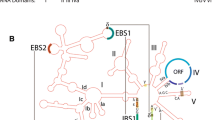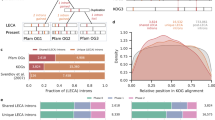Abstract
The debate on the origin and evolution of the intron/exon structure of eukaryotic genes has witnessed profound changes in the last 10 years. Concepts from both the introns-early and introns-late theories have merged into a new synthetic theory of intron evolution. Here I review the debate and discuss the perspectives for the future.
Access this chapter
Tax calculation will be finalised at checkout
Purchases are for personal use only
Preview
Unable to display preview. Download preview PDF.
Similar content being viewed by others
References
Berget, S.M., C. Moore & P.A. Sharp, 1977. Spliced segments at the 5′ terminus of adenovirus-2 late mRNA. Proc. Natl. Acad. Sci. USA 74: 3171–3175.
Bertolaet, B.L. & J.R. Knowles, 1995. Complementation of fragments of triose phosphate isomerase defined by exon boundaries. Biochemistry 34: 5736–5743.
Blake, C.C.F., 1978. Do genes-in-pieces imply protein-in-pieces? Nature 273: 267–268.
Buehner, M., G.C. Ford, D. Moras, K.W. Olsen & M.G. Rossman, 1973. D-Glyceraldehyde-3-phosphate dehydrogenase: three-dimensional structure and evolutionary significance. Proc. Natl. Acad. Sci. USA 70: 3052–3064.
Cavalier-Smith, T., 1978. Nuclear volume control by nucleoskeletal DNA, selection for cell volume and cell growth rate, and the solution of the DNA C-value paradox. J. Cell Sci. 34: 283–284.
Chow, L.T., R.E. Gelimas, T.R. Broker & R.J. Roberts, 1977. An amazing sequence arrangement at the 5′ ends of adenovirus-2 messenger RNA. Cell 12: 1–8.
Cornish-Bowden, A., 1985. Are introns structural elements or evolutionary debris? Nature 313: 434–435.
De Souza, S.J., M. Long & W. Gilbert, 1996a. Introns and gene evolution. Genes Cells 1: 493–505.
De Souza S.J., W. Fischer, J. Logsdon, M. Long, N. Mortin & A. Stoltzfus, 1996b. Intron positions correlate with modules boundaries in ancient proteins. Proc. Natl. Acad. Sci. USA 93: 14632–14636.
De Souza S.J., W. Fischer, J. Logsdon, M. Long, N. Mortin & A. Stoltzfus, 1997. The origin and evolution of introns: a debate. In: HMS Beagle: A Biomednet Publication (http://news.bmn.com/hmsbeagle/01/cutedge/day1.htm), vol. 1, issue # 1.
De Souza S.J., W. Fischer, J. Logsdon, M. Long, N. Mortin & A. Stoltzfus, 1998. Toward a resolution of the introns early/late debate: only phase 0 introns are correlated with the structure of ancient proteins. Proc. Natl. Acad. Sci. USA 95: 5094–5099.
Dibb, N.J. & A.J. Newman, 1989. Evidence that introns arouse at proto-splice sites. EMBO J. 8: 2015–2021.
Doolittle, W.F., 1978. Gene-in-pieces: were they ever together? Nature 272: 581–582.
Dorit, R.L., L. Schoenbach & W. Gilbert, 1990. How big is the universe of exons? Science 250: 1377–1382.
Fedorov, A. et al., 1992. Analysis of nonuniformity in intron phase distribution. Nucl. Acids Res. 20: 2553–2557.
Fedorov, A., X. Cao, S. Saxonov, S.J. De Souza, S.W. Roy & W. Gilbert, 2001. Intron distribution difference for 276 ancient and 131 modern genes suggests the existence of ancient introns. Proc. Natl. Acad. Sci. USA 98: 13177–13182.
Gilbert, W., 1978. Why genes in pieces. Nature 271: 501.
Gilbert, W., 1986. The RNA World. Nature 319: 618.
Gilbert, W., 1987. The Exon Theory of Genes. Cold Spring Harbor Symp. Quant. Biol. 52: 901–905.
Gilbert, W. and S.J. De Souza, 1999. Introns and the RNA world, pp. 221–232 in The RNA World, edited by R.F. Gesteland, T.R. Cech & J.F. Atkins. Cold Spring Harbor Laboratory Press, Colds Spring Harbor, NY.
Gilbert, W. & M. Glinias, 1993. On the ancient nature of introns. Gene 135: 137–144.
Gilbert, W, S.J. De Souza & M. Long, 1997. Origin of genes. Proc. Natl. Acad. Sci. USA 94: 7698–7703.
Gilbert, W., M. Marchionni & G. McKnight, 1986. On the antiquity of introns. Cell 46: 1377–1382.
Go, M., 1981. Correlation of DNA exonic regions with protein structural units in haemoglobin. Nature 291: 90–93.
Guerrier-Takada, C. et al., 1983. The RNA moiety of ribonuclease P is the catalytic subunit of the enzyme. Cell 35: 849–857.
Jensen, E.O. et al., 1981. The structure of a chromosomal leghaemoglobin gene from soybean. Nature 291: 677–679.
Kersanach, R. et al., 1994. Five identical intron positions in ancient duplicated genes of eubacterial origin. Nature 367: 387–389.
Kruger, K., P.J. Grabovski, A.J. Zang, J. Sands, D.E. Gottschling & T.R. Cech, 1982. Self-splicing RNA: autoexcision and auto-cyclization of the ribosomal RNA intervening sequence of Tetrahymena. Cell 31: 147–157.
Long, M., 2001. Evolution of novel genes. Curr. Opin. Genet. Dev. 11:673–680.
Long, M. & C. Rosemberg, 2000. Testing the ‘:proto-splice sites’ model of intron origin: evidence from analysis of intron phase correlation. Mol. Biol. Evol. 17: 1789–1796.
Long, M., S.J. De Souza & W. Gilbert, 1995a. Evolution of the intron-exon structure of eukaryotic genes. Curr. Opin. Genet. Dev. 5: 774–778.
Long, M., C. Rosemberg & W. Gilbert, 1995b. Intron phase correlations and the evolution of the intron/exon structure of genes. Proc. Natl. Acad. Sci. USA 92: 12495–12499.
Long et al., 1998. Relationship between ‘:proto-splice sites’ and intron phases: evidence from dicodon analysis. Proc. Natl. Acad. Sci. USA 95: 219–223.
Marchionni, M. & W. Gilbert, 1986. The triose phosphate isomerase gene from maize: introns antedate the plant-animal divergence. Cell 46: 133–141.
Ohno, S., 1970. Evolution by Gene Duplication. Springer-Verlag, Berlin.
Palmer, J.D. & J.M. Logsdon, 1991. The recent origin of introns. Curr. Opin. Genet. Dev. 1: 470–477.
Rossman, M.G. & A. Liljas, 1974. Recognition of structural domains in globular proteins. J. Mol. Biol. 85: 177–181.
Roy, S., M. Nosaka, S.J. De Souza & W. Gilbert, 1999. Centripetal modules and ancient introns. Gene 238: 85–91.
Shiba, K., 1995. Dissection of an enzyme into two fragments at intron-exon boundaries, pp. 11–21 in Tracing Biological Evolution in Protein and Gene Structures, edited by M. Go & P. Schimmel. Elsevier Science, Amsterdam.
Stoltzfus, A., D.F. Spencer, M. Zuker, J.M. Logsdon Jr. & W.F. Doolittle, 1994. Testing the Exon Theory of Genes: the evidence from protein structure. Science 265: 202–207.
Stoltzfus, A., J.M. Logsdon Jr., J.D. Palmer & W.F. Doolittle, 1997. Intron sliding and the diversity of intron positions. Proc. Natl. Acad. Sci. USA 94: 10739–10744.
Strauss, D. & W. Gilbert, 1985. Genetic engineering in the pre-cambrian: structure of the chicken triose phosphate isomerase gene. Mol. Cell. Biol. 5: 3497–3506.
Tittiger, C, S. Whyard & V.K. Walker, 1993. A novel intron site in the triose phosphate isomerase gene from the mosquito Culex tarsalis. Nature 361: 470–472.
Author information
Authors and Affiliations
Editor information
Rights and permissions
Copyright information
© 2003 Springer Science+Business Media Dordrecht
About this chapter
Cite this chapter
de Souza, S.J. (2003). The emergence of a synthetic theory of intron evolution. In: Long, M. (eds) Origin and Evolution of New Gene Functions. Contemporary Issues in Genetics and Evolution, vol 10. Springer, Dordrecht. https://doi.org/10.1007/978-94-010-0229-5_2
Download citation
DOI: https://doi.org/10.1007/978-94-010-0229-5_2
Publisher Name: Springer, Dordrecht
Print ISBN: 978-94-010-3982-6
Online ISBN: 978-94-010-0229-5
eBook Packages: Springer Book Archive




